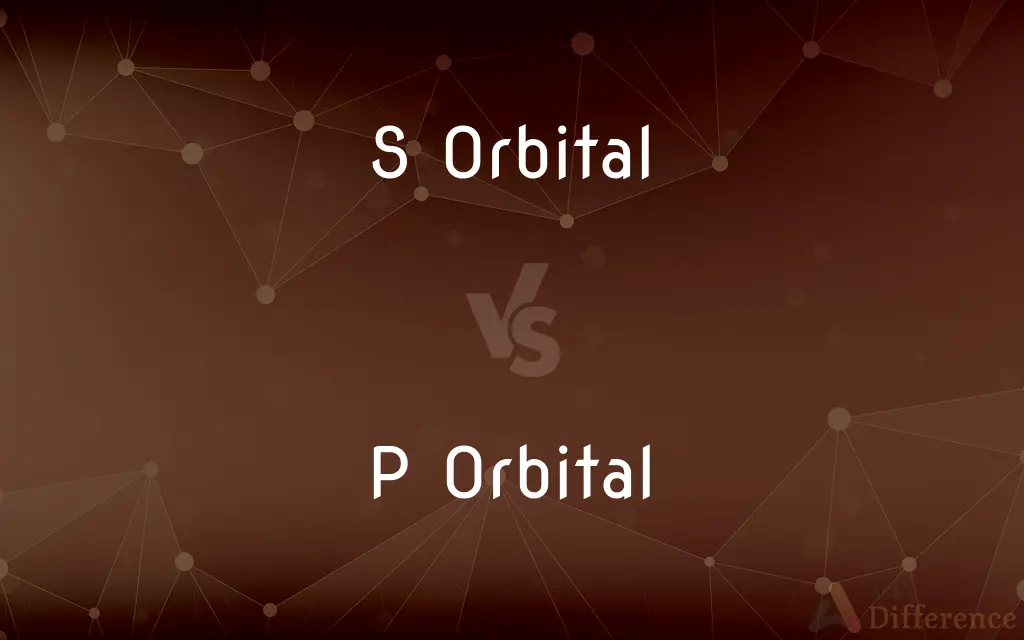S Orbital vs. P Orbital — What's the Difference?
By Tayyaba Rehman — Published on November 24, 2023
S Orbitals are spherical, housing up to 2 electrons, while P Orbitals are dumbbell-shaped, accommodating up to 6 electrons.

Difference Between S Orbital and P Orbital
Table of Contents
ADVERTISEMENT
Key Differences
S Orbitals and P Orbitals present themselves as distinct architectural spaces for electron habitation within an atom, framing the atomic structure with their unique geometric shapes and electron capacities. S Orbitals seamlessly craft a spherical space, nestling up to two electrons within its symmetrical form. In stark geometrical contrast, P Orbitals carve out a dumbbell-shaped residence, hospitably accommodating up to six electrons, asserting their space in three-dimensional directional lobes.
Exploring deeper, S Orbitals, with their simplistic spherical aura, inaugurate the electron configuration for each principal energy level in atoms, being the primary electron domicile in the hydrogen atom. P Orbitals, offering a more complex spatial arrangement, make their debut in the second energy level, contributing to the electron configuration with three perpendicular orientations: px, py, and pz, thereby enhancing the electron-distribution complexity in atoms from the second energy level onward.
The roles of S Orbitals and P Orbitals intertwine with the periodic table, influencing the arrangement and electronic characteristics of elements in a sequential and structural manner. Specifically, the S Orbital, with its maximum two-electron capacity, shapes the first two groups of the periodic table, engendering the alkali and alkaline earth metals with their distinctive properties. Conversely, the P Orbital, with its ability to nestle six electrons, structures the p-block of the periodic table, infusing variability into the properties of elements ranging from group 13 to group 18.
Electron configuration within S Orbitals and P Orbitals sculpts the chemical and physical properties of elements, guiding their behavior in various chemical contexts. The electrons in the S Orbital, especially those in the valence shell, often partake in metallic bonding, reflecting in the metallic properties of groups 1 and 2. P Orbitals, enriching the electron cloud with their three varied directional lobes, engender diverse bonding and molecular shapes, especially in covalent compounds, thereby crafting the multifaceted nature of p-block elements.
Transitioning into the quantum realm, S Orbitals and P Orbitals also become primary actors in molecular orbital theory, which elucidates the electron structure and bonding in molecules. S Orbitals, with their spherical symmetry, facilitate head-on overlap, forming sigma (σ) bonds in molecular structures. In a vividly different dynamic, P Orbitals engage in both head-on and sideways overlap, enabling the formation of sigma and pi (π) bonds, respectively, thereby contributing to the structural diversity and stability of various molecules.
ADVERTISEMENT
Comparison Chart
Shape
Spherical
Dumbbell-shaped
Electron Capacity
Up to 2 electrons
Up to 6 electrons
Beginning Energy Level
1st
2nd
Number of Orientations
1 (s)
3 (px, py, pz)
Role in Periodic Table
Defines groups 1 and 2
Structures p-block (groups 13 to 18)
Compare with Definitions
S Orbital
Bipartite Electron Host
Helium's S Orbital hosts two electrons, completing its electron configuration.
P Orbital
Dumbbell-shaped Electron Locale
Carbon's P Orbitals play a crucial role in forming pi bonds in ethene.
S Orbital
Spherical Electron Shield
The S Orbital shapes the electron shield effect in alkali metals.
P Orbital
Triple-Lobed Electron Residence
Boron utilizes its P Orbital to engage in bonding with three other atoms in BF3.
S Orbital
Initial Energy Level Occupant
In each energy level, the S Orbital is the first to accommodate electrons.
P Orbital
Multi-Directional Electron Host
The P Orbital in chlorine participates in forming the Cl2 molecule via a sigma bond.
S Orbital
Symmetrical Electron Sphere
The S Orbital in hydrogen encapsulates its singular electron in a spherical domain.
P Orbital
Six-Electron Carrier
The P Orbital in oxygen accommodates four of its electrons in two of its three lobes.
S Orbital
Non-directional Electron Residence
In sodium, an electron resides in the 3s S Orbital, which lacks directional lobes.
P Orbital
Three-dimensional Electron Habitant
In nitrogen, P Orbitals facilitate the formation of a pi bond in N2.
Common Curiosities
What shape does the S Orbital have?
The S Orbital has a spherical shape.
Do S Orbitals participate in covalent bonding?
Yes, electrons in S Orbitals can engage in covalent bonding.
Which elements have electrons in S Orbitals?
All elements have electrons in S Orbitals as they exist in every energy level.
How many electrons can a P Orbital hold?
A P Orbital can hold up to 6 electrons.
Which block of the periodic table is influenced by P Orbitals?
P Orbitals influence the p-block of the periodic table.
How many types of S Orbitals exist in an energy level?
There is only one type of S Orbital in each energy level.
What is the significance of the orientations of P Orbitals?
The orientations of P Orbitals allow them to engage in various bonding configurations and directions.
Can P Orbitals form pi bonds?
Yes, P Orbitals can form pi bonds through sideways overlap.
Can S Orbitals engage in pi bonding?
No, S Orbitals cannot engage in pi bonding due to their spherical shape.
What is the maximum electron capacity of S Orbitals in an atom?
S Orbitals can hold a maximum of 2 electrons.
How many types of P Orbitals exist in an energy level?
There are three types of P Orbitals in an energy level, designated px, py, and pz.
Are P Orbitals present in hydrogen?
No, P Orbitals are not present in hydrogen as they first appear in the second energy level.
In which energy level do P Orbitals first appear?
P Orbitals first appear in the second energy level.
Are S Orbitals involved in defining atomic size?
Yes, electrons in S Orbitals contribute to defining atomic size by shielding the nuclear charge.
What role do S Orbitals play in alkali metals?
S Orbitals host the valence electrons in alkali metals, influencing their reactivity.
Share Your Discovery

Previous Comparison
Lysine vs. L-lysine
Next Comparison
Think Of vs. Think AboutAuthor Spotlight
Written by
Tayyaba RehmanTayyaba Rehman is a distinguished writer, currently serving as a primary contributor to askdifference.com. As a researcher in semantics and etymology, Tayyaba's passion for the complexity of languages and their distinctions has found a perfect home on the platform. Tayyaba delves into the intricacies of language, distinguishing between commonly confused words and phrases, thereby providing clarity for readers worldwide.
















































